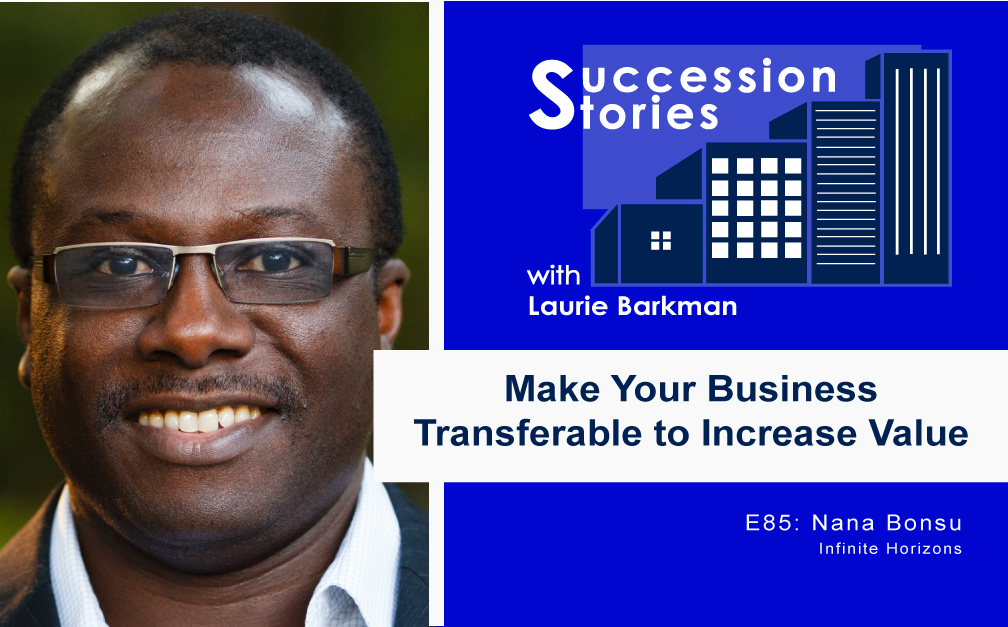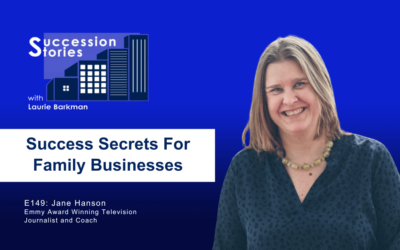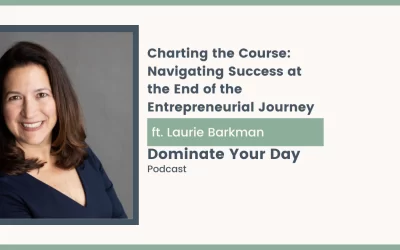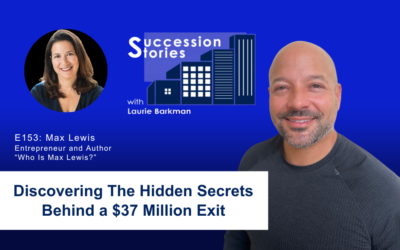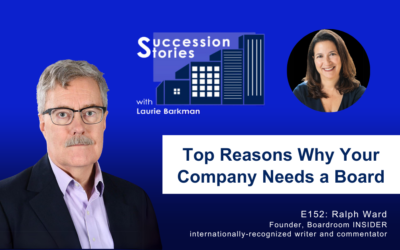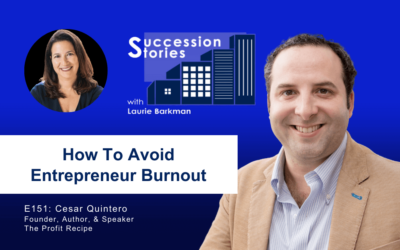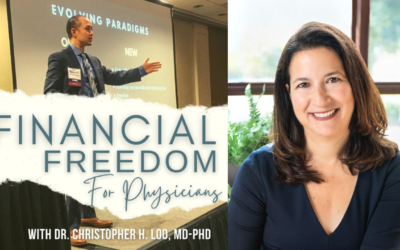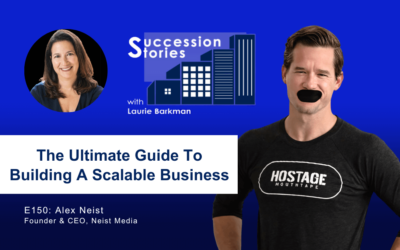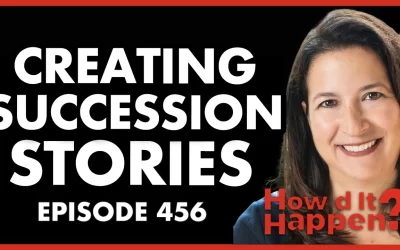This week on Succession Stories, Laurie Barkman hosts fellow Certified Value Builder Advisor, Nana Bonsu for a conversation on business growth and transferability. Nana is the Founder CEO of Infinite Horizons, and he works with business owners on building value to make them easier to transfer during the M&A process. This discussion touches on common misconceptions owners often have about their business value, future readiness, and tackling key challenges that come up during transition.
Listen in to learn more about:
- The underlying importance of growth potential
- How transferability affects business value
- Key value drivers for your business
- Scalability Finder strategies and differentiation
Show Links:
https://www.linkedin.com/in/nanabonsu1
https://infhorizons.com/about-certified-value-builder-advisor/
Laurie’s appearance on Nana’s podcast, Build Value By Choice
Don’t leave your exit to chance.
Stony Hill Advisors works with owners like you to get ready and maximize value when you’re ready to sell.
Visit www.stonyhilladvisors.com/podcast for a complimentary business valuation.
About Succession Stories Podcast
Succession Stories is hosted by Laurie Barkman, the Business Transition Sherpa– guiding business owners through the process from “transition to transaction.”
Learn more at https://thebusinesstransitionsherpa.com
Book a 1:1 Advisory call at: www.meetlauriebarkman.com
We appreciate your support…subscribe, share, and post a review to share what you like about the show!
Transcript
Nana Bonsu is the Founder of an Exit Planning Advisory firm, Infinite Horizons, We met because we are both Certified Value Builder Advisors and have a passion for podcasting. I was recently a guest on his show, Build Value By Choice, and encourage you to give Nana’s show a listen as well. Podcasters like Nana bring you great content at no charge, and we appreciate when you subscribe and share the show. Nana and I had a great conversation about Transferability– oftentimes the biggest obstacle you may face to exiting your company in the future. We also talked about common misconceptions about exit value planning and how you can protect business value in both the short and long term. Enjoy my conversation about making your business more transferable to maximize value with Nana Bonsu.
Laurie Barkman:
Nana Bonsu, welcome to Succession Stories. I am so excited to talk to you today because it’s always great to speak to someone who’s reading off the same song sheets. You and I are both Certified Value Builder advisors and that’s how we got connected and I’m looking forward to our conversation about transferability, and how we help business owners create a more transferable valuable company, so welcome.
Nana Bonsu:
Thank you. Thanks for having me, Laurie.
Laurie Barkman:
Why don’t we start with you? Can you share a little bit about your background and how you got started as an advisor to business owners?
Nana Bonsu:
Back in 2020, during the COVID pandemic. That’s when I was a little bit stressed. I was just from having worked in a big company and through my engineering background, I had supported M&A from acquiring different businesses. I realized that I did, and also having either founded or co-founded a couple of businesses that was where my calling was. So in looking around, I got hooked up with Mindvalley and then through that I hooked up with Dr. Whateley. Then through that guy hooked up with another advisor, who helped me do some research and I came across Value Builder.
The reason why I liked the Value Builder System was because in my previous experience we had to build frameworks from scratch, where the Value Builder System actually had a system that was able to help an advisor build a marketing and sales system. That to me was the big multiplier, not to mention that it was proven with thousands of businesses had used the system to actually develop value. In talking to them, and in talking to other advisors who had been through the system, and in applying my previous business, using the system and the methodology to my previous business, it just seemed to work. That is what attracted me, I decided to give it a trial run and I went ahead and got certified. That’s been my journey. I did a couple of pilots with a couple of people, they liked it, they did well and so I decided to keep it going.
Laurie Barkman:
Great. That’s awesome. You had a career transition of your own so the topic of transitions is probably close to your heart and that’s something we talk about a lot on my show and when I was a guest on your show, which I appreciate. We should let everybody know that you have a podcast called Build Value by Choice, and what we do together, I think, is have a great conversation now about what is this topic about value building. What does this mean to a business owner? Let’s break it down a little bit so folks can understand some of the language we’re using here. Value Builder is a platform, it’s a software platform, and we use it as advisors with wonderful learning modules but, of course, we’re bringing something to the table too, which is our experience and with all of your engineering experiences and technical companies, and your strategic planning background, I’m sure that again, you bring a lot of things to the table with your clients. Let’s talk a bit about value drivers. There are roughly eight of them, if we boil them down, which value drivers do you focus on first with your clients?
Nana Bonsu:
I tend to focus on the growth potential. And that’s because it’s tied into what is called the scalability find, even though it’s now one of the value drivers. To me, that is fundamental and I always…the Good To Great book has had a huge influence on my strategic planning thinking as far as business goes, and it talks about the hedgehog concept.
Laurie Barkman:
What is that? What’s the hedgehog?
Nana Bonsu:
A hedgehog, as you know, is this little animal that anytime a predator comes after it, it can roll itself into a ball with spikes to fend people off, so it’s just about identifying three key intersecting things that make you unique, you’re passionate about and drives your economic or your resource engine and once you figure that out, then you can start growing and start differentiating yourself and then applying technology to accelerate that for long term, building to last and being able to transfer it for building a legacy and longevity. That to me is the cost of the foundation. If you don’t have the right foundation, you hang in the leaves off of the wrong truck.
Laurie Barkman:
Let’s go a step deeper. We’re talking about driving growth. Why is that so important? Why is that the first answer you gave me? Why growth potential?
Nana Bonsu:
Well, because of a couple of things. Number one is that at some point, the one thing that is for certain is that everybody’s going to exit or leave this planet at some point or retire at some point. If we look at that as a starting point, right, let’s just draw that line as your finishing line. Whether it’s voluntary or involuntary, somebody is going to have to take it over and so the question is, the value is that that’s the starting point for that person. How much growth, how much runway do they have after they take over from your finish line? That is what is key as far as the growth potential for your business, because it’s not about your past performance. It’s about the future potential for your financial performance and that’s why that is so important.
Laurie Barkman:
I think it’s also probably worth noting size matters for companies and companies of a certain size, we do talk about the size discount. Oftentimes people say, “Oh, well, what’s the revenue threshold?” It’s probably around 5 million, 10 million, certainly a million and under, where you have more mainstream businesses are viewed as more risky, because it tends to be so centered around the owner, and a company that is larger in revenue that’s more well established, that has the the financials behind them to show, as you said, it’s about the future potential. But also, isn’t it about what financials are in place today, because if there’s going to be a transfer of ownership, the new owners want to know that there’s going to be a predictable flow, the future cash flows need to be there and if it’s all about the business owner, and the business is so tied to that owner, this success is so tied, then it could hamper that growth potential, right and won’t be as transferable, so I agree with you that growth potential is a great place to start. I do also want to acknowledge that the financial side plays into it as importantly, because of the reasons I just said, what do you think about that?
Nana Bonsu:
No, I mean, they’re kind of interrelated and I think that is absolutely spot on. Maybe that’s probably because I just kind of assumed it’s kind of embedded, it’s kind of woven in there somehow, because the growth potential has to do with the growth in profits there. In the last three years, if you were able to grow profits 10 to 20% a year, if you’re not going to grow that same amount in the next couple of years, then your valuation is going to come down so the growth in size, the growth in the revenue, the growth in your profits, right, and, of course, the reduction in the risk. That’s what makes it so they are definitely interrelated to financial performance in the good potential. Absolutely two key drivers to look at.
Laurie Barkman:
You mentioned the scalability finders, you’re referring to one of the modules in the platform, which is a fantastic module. I use it also in workshops that I do, just to give people a sense of “What does it mean to create a scalable business?” As you were saying earlier with this hedgehog concept, where if we can discover what is a niche, what is that market niche, what differentiates the business? What should they be scaling on and then how to do it? Maybe you could explain the scalability finder exercise just at a high level, so we get a sense of what it is that from a nuts and bolts standpoint, what we’re talking about?
Nana Bonsu:
Yeah, so the key thing is that you can add growing in everything, because if you grow the wrong thing, you may need to so for instance, the current environment where there are acute labor shortages and an acquisition of talent and in this inflation, all these different different thing, the key thing is the three things to identify using the scalability final your hedgehog, right? You look at what you buy and sell, right? What products and services to buy and sell and so the question then is, how teachable are those products and services?
You mentioned the owner dependency earlier. If your products or services are highly teachable, then that means the owner doesn’t get to not be as involved as much, right, and then you take data use, okay, how, how valuable is it? How much can you differentiate yourself from other competitors or other folks in your industry for that particular product or service? That intersection then provides you something because if the customers don’t care about it, that’s not going to drive your economic engine very well and then, on top of that, you find okay, how repeatable is it? Then you just say, okay, because if it’s not repeatable, it’s just a one time thing, again, that is not going to drive growth. That’s just not economically viable so you have those three inner circles. Once you have that, then you have the products and services that can grow, that can scale that way. If you could focus on differentiating yourself and those things, then you have the springboard in which to grow, to scale, to make your business more transferable.
Laurie Barkman:
Excellent. For business owners that you talk to, how do you think they would answer this question? And the question is, “What’s the biggest obstacle you’re facing in transitioning your company in the future?” That’s been a survey question that’s been out there from organizations like BEI and they’ve asked that, and I know the answer, generally, but I’m curious to hear what your conversations sound like.
Nana Bonsu:
Yeah, it’s kind of varied, but it tends to come down to two things, the main stance typically is that they don’t think anybody could do the work as well as they can. because after all, the business, a lot of times, especially if they started the business is based off of their intellect, the certain spirit that they had that you can’t just transfer to somebody and so that is normally the biggest thing, which is that nobody can run the business as well as they can, the business will lose its identity. But a lot of times, I think it also has to do with it…it’s not sad, but when you peel the onion, a lot of times it has to do with fear, so their fear of what’s next. Because if the business was their calling, right, what’s the next calling after that? That is unstated but a lot of times, when you peel the onion, sometimes that’s what it comes down to, but they tend to think that nobody can do it as well as they can, because the identity and disparatism is embodied in that business.
Laurie Barkman:
Well, I was going to ask you another question, but I think you’ve sort of answered it, because the question is going to be, what’s the number one myth or misconception that business owners might have about Exit Planning? And I think I would guess you’d probably answer the same thing, which is that no one can do what they’re doing in their business. How do you coach them out of it?
Nana Bonsu:
Well, I mean, I think a couple of things. The way to coach them out of it is, number one, try to get them to have other interests, right, and so the the draw to do something else gives them the motivation to be able to transfer as much of it as possible, bring people along along, bring somebody, a succession plan, in this case, some kind of succession plan, even if it’s not formal, mentor somebody who can at least do it as well as possible up to maybe 90%-95% where the owner doesn’t have to be there as much and so it’s about systematizing your business. That’s the number one thing that I coach them on.
Laurie Barkman:
Do you work with any particular types of companies in certain industries, or size?
Nana Bonsu:
I tend to focus on companies generating $10 million in annual revenues or less and because of my background in IT, in financial services, also, I tend to work in those industries. I’ve also worked with e-commerce people, that fascinates me, of course, not to mention educational technology companies.
Laurie Barkman:
A nice mix, yeah, so there’s some services in their products. What would be something that if a business owner is listening, and they want to get started, what would be the three things that you would say they should start doing in the next three months?
Nana Bonsu:
If they want to get started doing what exactly?
Laurie Barkman:
If they want to get started, they want to learn about Exit Planning, or they want to think about their business transition, maybe what are some of the key questions they should be pondering today?
Nana Bonsu:
Right. Great question. There are a couple of things. It’s about the journey, it’s about the phases. The one thing that you need to understand is that in the transition or the transfer phase, you want to go out on your own terms, right? It can’t just be, “Okay, yes.” The exit plan or the transition planning because of the other myth is a lot of times the exit point, the term exit, or the word exit sometimes connotes like death or something, The exit plan is not about your life after death, it’s actually about your life on Earth right now and so you have to think about number one, the first thing you need to think about is what options — how would you begin with the end in mind like Stephen Covey says, and understand what options you have, because a lot of times business owners just only think of one or two options.
They need to educate themselves by identifying somebody, an advisor, somebody who can help them find what options are on the table for them and then once they identify those options, they can pick in ranking order, which ones appeal to them. Once they do that, then they can then work with an advisor, it could be a wealth management advisor. They could have a team. He could have a team or she could have a team and identify how much money if they were to either retire or go do something else is going to be enough to fund your lifestyle. Once they have that number, then they need to then identify what is then — so that’s the second. The third thing is, how much is your business worth? Is their business, the worth of their business enough to cover their financial requirement to fund their lifestyle? If there’s a gap, that’s when they need to, then the fourth one would be, how do they build up their business value? That’s when they talk to somebody like you or me. I could be the same person helping them with the exit planning as well.
Laurie Barkman:
Excellent. Couple of fun questions for you because I know you live in Maryland, but I’m guessing you’re not originally from Maryland. Where are you from originally?
Nana Bonsu:
Originally born in New York but raised in Ghana, where my grandparents are from, South Africa, kind of lived all over the place so I’m kind of like a military child; New York City by birth, raised in Ghana, I lived in a couple of different states, but lived in Maryland like continuously since 97 so that would be about 25 years now.
Laurie Barkman:
Excellent. When you’re not working, what keeps you busy?
Nana Bonsu:
Interesting. A couple of things. I like watching sports, I’m into soccer. I watch all kinds of sports. I used to watch all kinds of sports but what keeps me busy is sports. I like walking around the neighborhood. That interests me quite a bit and spending time with family.
Laurie Barkman:
Some of the simpler things in life. I love it. Very simple. Okay. Well, last question for you. Rounding out two questions. One is, if you have a favorite quote that inspires you you’d like to share?
Nana Bonsu:
Well, I mean, Benjamin Franklin said, ‘Don’t put up till tomorrow that which you can do today’. As a business owner, I want to put up this idea of transition planning because that is part of the business planning process and so the sooner you can talk to an advisor about it, the better off you’ll be. You don’t want to have any regrets sometime down the line, so that would be my favorite quote.
Laurie Barkman:
Because Exit Planning isn’t a negative, it is part of business planning, something that every owner should do. I love that. If people want to get in touch with you, Nana, what’s a great way for them to reach out and find you?
Nana Bonsu:
They can reach me on LinkedIn or Facebook. They can also reach me via email nbonsu@infhorizons.com or they can go to our website, infhorizons.com.
Laurie Barkman:
Awesome. Nana, thanks so much for being with me today. It was really fun.
Nana Bonsu:
Thanks for having me.

